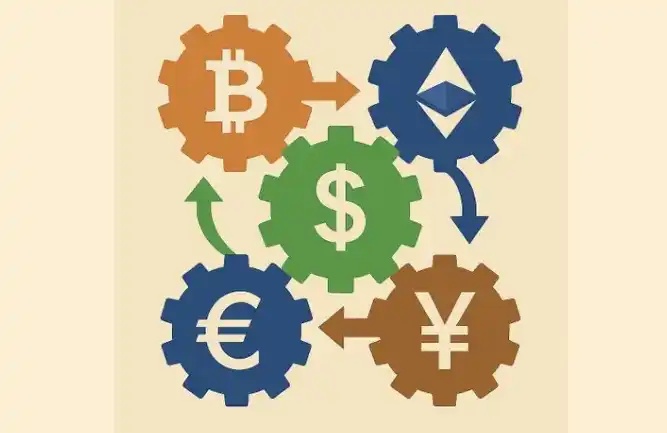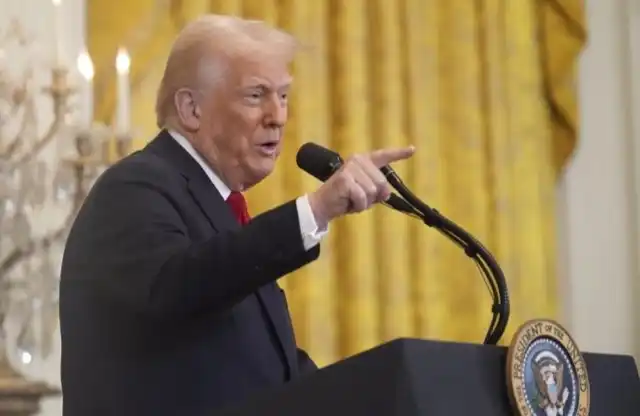The Arrival of the Latest Tariff Version: Will There Be a Post-Announcement Rally? | Trader's Insight
Last night, President Trump signed two executive orders at the White House regarding the so-called "reciprocal tariffs," announcing that the U.S. would establish a 10% "minimum baseline tariff" on its trading partners and impose higher tariffs on certain trading partners. A senior White House official stated that the baseline tariff rate (10%) would take effect early on April 5, with the reciprocal tariffs taking effect early on April 9.
U.S. Treasury Secretary Bennett tweeted, "I suggest all countries refrain from taking retaliatory actions. We can see if there will be a different lower limit for tariffs (from the announced figures). Trump's mindset might be to temporarily stabilize the situation. I was not involved in the negotiations; we need to see if there will be any negotiations before April 9 (the effective date of reciprocal tariffs)."
The crypto market experienced a long and short dual kill last night. When the announcement of a 10% baseline tariff was made at the beginning of the meeting, Bitcoin briefly surged to $88,000, hitting a high since March 25, up over 5%; however, it was later revealed that additional tariffs would be imposed on about 60 countries with the largest trade imbalances with the U.S. Bitcoin retraced most of its gains, dropping below $82,500. Based on Bitcoin's current performance, it can be said to have no safe-haven properties. Meanwhile, spot gold briefly broke through $3160 per ounce, hitting a new all-time high.
Related reading: "U.S. Stocks Evaporate $2 Trillion in 15 Minutes, Is 'Reciprocal Tariffs' the Final Straw that Broke the Bull Market's Back?"
This not only plunges the global trade system into a new round of policy chess, but also sets off a tsunami of chain reactions in the financial markets. From Bitcoin's roller-coaster-like volatility to gold hitting a new all-time high again, the market is interpreting the deep-seated anxiety over the escalation of the trade war through the language of prices. BlockBeats has compiled traders' interpretations of the tariff policy, outlook for the future, and market analysis for readers' reference.
Macro Analysis
With Trump's tariffs in place, how should we view the follow-up? Trump's tariff plan was finally announced early in the morning, basically the toughest version expected (initially, the baseline tariff rate was relatively low).
1. Key points of the tariff policy:
1) Reciprocal tariff policies are implemented against 50 countries and regions worldwide, with a baseline tariff rate of 10%. However, the additional tariffs imposed on each country are basically half of the U.S.'s import tariff rate imposed by the other party. The global auto tariffs are set at 25%.
2) Other reciprocal tariff policies did not take immediate effect and will finally take effect on April 5, providing a certain negotiation opportunity.
3) Trump still emphasized the vision of revitalizing American industry, bringing high-end industries such as shipbuilding, aircraft, and semiconductors back to the United States. He emphasized the increased investment of large multinational companies in the United States, once again advocating that multinational companies establishing a presence in the United States will avoid higher tariffs, with the core focus being to stimulate industrial reshoring.
2. How to view the tariff policy?
1) First, as discussed before, aside from automobile tariffs, reciprocal tariffs do not take immediate effect. There is still room for maneuvering before they take effect on April 5. The key point here is to see how China, the European Union, and Japan and South Korea will react. Will China retaliate strongly? The European Commission previously mentioned waiting to discuss response measures until after Trump's tariff policy is announced.
Mexico was not mentioned today, so it seems to be treated separately. This further confirms the speculation that Trump wants to build a North American tariff alliance fortress with Mexico and Canada.
2) Yesterday, Treasury Secretary Mnuchin told Congress that the tariffs announced on Wednesday are at the highest level, and countries can take measures to reduce tariffs. This clearly suggests that everyone should negotiate; proactively reducing tariffs and cooperating will likely lead to a reduction in your tariffs.
Yesterday, the President of Mexico has expressed that they will not implement retaliatory measures. Previously, Israel, Thailand, and Vietnam all announced plans to reduce import tariffs.
From this perspective, it feels like if other countries reduce tariffs, they should come down as well.
3. How to view the subsequent market?
Today, the tariffs are being implemented, which can be seen as the toughest version previously anticipated. When talking about the toughest version being implemented, the market is likely to use these policy figures to anticipate and price in the worst-case scenario, resulting in a huge impact on the market. Currently, U.S. stock index futures are sharply down, and the major cryptocurrency has surged and then fallen significantly back, all reflecting pricing in this worst-case scenario, although the pricing may not be fully reflected yet.
Wait for the clearance and wait for good news to come.
Looking at it from a different perspective, the next few days from today until the 5th are likely the peak of recent uncertainty, and the worst-case scenario has already emerged. After that, various countries will engage in negotiations with the United States, and any positive progress will boost market confidence.
As we discussed before, whether tariffs are a club or a result is still uncertain. According to Trump, the 10% reciprocal tariff will officially take effect on April 5, and the additional retaliatory tariff, which is the portion beyond the 2, will be officially implemented on April 9, which is April 10 Beijing time.
This means there is still a week to give all countries subject to tariffs higher than 10% an opportunity to adjust. If these countries are willing to reduce tariffs on the United States to 10%, then U.S. tariffs on these countries will also be adjusted to 10%, except for China, and this time Mexico and Canada are not part of the discussion. It's too early to talk about the final outcome now; let's wait until April 9.
Overall, if the current data is formally implemented, a major trade war will erupt, which is definitely not a good thing.
Inflation and the economy are both worrying.
Returning to BTC data, I don't want to say too much. Let's wait and see. There may be FUD during Asian hours tomorrow, as the impact on China is significant, and China is likely to impose retaliatory tariffs. It's unclear for Japan and South Korea. As I've always said, the difficulty in April will increase.
Overall Comments on Tariffs
1. A 10% increase in tariffs for all countries overall is a positive scenario.
2. Individual country-specific tariffs are a huge negative, including 34% for China and 20% for the EU, which is relatively less (EU exports to the U.S. are mainly luxury cars, agricultural products, and luxury goods).
3. Equivalent tariffs for other countries are also very high (Vietnam is also a major exporter).
4. Currently, it seems that equivalent tariffs for each country do not differentiate by industry. Industries like clothing in China will be significantly impacted by inflation. It may also be that detailed rules have not yet been established.
5. The only good news is that Canada and Mexico are not subject to tariffs.
6. Equivalent tariffs will be implemented on April 9, so there may still be some time for rescue (time for countries to negotiate terms with the U.S.).
7. If the final decision is based on the currently provided numbers, it will be very detrimental to the U.S. economy, inflation, stock market, and cryptocurrency market.
8. If the final decision is based on the current numbers, Bitcoin is expected to reach a high point this week at 88,500 today. Next week is the U.S. tax season, and liquidity is expected to remain low.
9. After the bottoming out of this month's decline, the rebound peak is expected to not exceed 95-96, possibly reaching a maximum of 90-91.
10. Currently, the probability of the U.S. entering a recession after July is very high. If there is a rebound in May or June, then prepare for an escape wave.
Technical Indicators
ASR-VC Indicator 4h Channel Status Update:
Failed to break through the midline, understandable given the recent U.S. stock market downturn. The fact that BTC can still find support in the demand area is already quite good!
It is evident that the two sub-demand and supply areas on the chart have played a very significant role in price action, indicating that the current market is not undergoing a structural change but is still within its existing range-bound structure;
Similar to the logic in the quote, starting this week, short-term volatility is expected to gradually increase until a breakthrough or breakdown of the key range. Trading difficulty is also rapidly rising, with multiple gates expected to be drawn from Monday onwards, and the first one has already been drawn!
Subjectively speculating, this gate is definitely not the last one...
Still, the price is oscillating near the midline, directionless, completely random, and influenced by event news sentiment. Technical analysis is only suitable for small timeframes, either for short-term gains or to stay out of the market.
From a BTC liquidity perspective, last week, MSTR bought 22,000 BTC at an average price of 86900, but it still didn't push the price up, indicating a significant selling pressure in the 86-87 range. Last night, it spiked to 88500, consuming this selling pressure; going up again will be very easy. The spike last night did not break through the local previous high near 88760, which is a good sign. The liquidity above was not captured, setting the stage for the next upward movement. The next leg up has a midway point between 93-97k, where multiple former high-pressure levels need to be worn down, leading to another gradual uptrend in the range of two to three thousand points up and down. The ultimate liquidity point is between 100-105k, which is where it's advisable to gradually exit all cryptocurrency holdings.
1. Currently, we are in a weekly downtrend, and the bullish play is a sub-level rebound within the weekly downtrend.
2. From a higher timeframe perspective, assuming the high point is 109,588 and the low point is 76,606, forming the first part of the correction, the current trend is defined as a rebound from the initial downtrend. Due to news impact, yesterday's daily candle showed a long upper shadow with a bearish body, indicating an unfavorable movement, likely to continue back within the downtrend line.

3. The current rebound has two potential scenarios:
1) 76,606 ➡️ 88,765 is the first part of the rebound, 88,765 ➡️ 81,279 is the second part of the rebound, and the uptrend from 81,279 marks the third part of the rebound;
2) 76,606 ➡️ 88,765 has already completed the entire rebound, and at this point, it is continuing to establish a continuation of the downtrend.
4. Looking at a smaller timeframe, it was mentioned yesterday that during the uptrend rebound process, the trendline resistance was temporarily breached, but the horizontal resistance was not yet surpassed. As a result, at the horizontal resistance level, the price was promptly rejected back;
1) Only a breakthrough around 88,700 will strengthen the rebound;
2) Only a breakthrough around 91,000 will allow for a more extended view of the rebound.

5. Operationally, although there was no loss, the market did not follow the expected path. The expectation was for a news-driven stimulus, a gentle implementation of tariff policies, to promptly boost the market above the 90,000 level, followed by the construction of a strong rebound continuation. However, the market stimulus was a forceful implementation of tariff policies, leading to a direct rejection around the 89,000 level;
6. Anticipation and assumption: as time progresses, the candlestick and downtrend resistance line will inevitably intersect. At that point, two possibilities arise:
1) Passive breakthrough, meaning the trendline has pushed down, but the price has not yet dropped, resulting in a natural breakthrough of the downtrend line. This scenario is not robust. Subsequently, a more extended and volatile continuation will be constructed;
2) As the trendline descends, the candlestick encounters resistance, causing the price to continue downward. This scenario may be relatively swift, with both upper resistance and lower support levels visible in the chart. Please refer to the chart for details:

7. Currently, I am back to a cash position. Since the primary market driver is the policy landscape, during this window, it is essential to patiently observe various countries, markets, central banks, especially the U.S. and China, to assess their reactions to the tariff policies before deciding on a position. The overall higher timeframe still maintains a bearish trend, and this rebound's subjectively anticipated favorable factors have been debunked. Thus, we must await the outcome of the game. I believe that other smaller countries will generally benefit from tariffs, with China having the highest level of uncertainty and influence. At this point, I am looking forward to a scenario of "no breakthrough, no progress," as the current back-and-forth is draining.
Welcome to join the official BlockBeats community:
Telegram Subscription Group: https://t.me/theblockbeats
Telegram Discussion Group: https://t.me/BlockBeats_App
Official Twitter Account: https://twitter.com/BlockBeatsAsia
 Forum
Forum OPRR
OPRR Finance
Finance
 Specials
Specials
 On-chain Eco
On-chain Eco
 Entry
Entry
 Podcasts
Podcasts
 Data
Data









